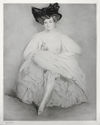
19th, 20th & 21st Century Fine Prints
707-546-7352 · fax 707-546-7924 · web: www.annexgalleries.com · email: artannex@aol.com
Edgar Chahine Biography
Edgar Chahine
Armenian/French
1874–1947
Biography
Painter, printmaker, and illustrator Edgar Chahine was born in Austria in 1874, the son of Armenian parents. His family relocated to Constantinople when Edgar was very young, and at age eighteen he began his art studies with the financial support of his father, who was director of the Ottoman Bank. Hoping to gain more exposure to an active art society, he first traveled to Italy, enrolling at the prestigious Armenium Lyceum Moorat Raphael in Venice and the renowned Academia di Belle Arti, where he studied under Antonio Ermolao Paoletti. In 1895 he moved to Paris, taking courses at the Académie Julian under Benjamin Constant and Jean-Paul Laurens. He soon saw success exhibting at the Societe des Artistes Francais.
Of particular inspiration to Chahine was the daily life of the poor and middle classes. Though living in the vortex of the international art world at the height of a lavish art scene dedicated to a gilded aesthetic, Chahine's subject matter very quickly turned toward portaying the lives of everyday people, including the conditions lived in by those seen as outcasts. His first painting included at the 1896 Paris Salon was titled "The Tramp," and the succession of paintings to follow would deal with similar themes of poverty.
It wasn't until 1899 that Chahine began to experiement with etching, but he quickly took to the medium and took up an apprenticeship with printmaker Eugene Delatre. He began to produce works with as much painterly dedication as his works on canvas and by the end of the year he had produced twenty-five intaglios. Of these he exhibited two etching and one drypoint at the 1899 Salon and he recieved immediate acclaim, prompting the publication of a catalogue of his works by collector and critic Clement Janin and inclusion in a variety of art periodicals. For the next decade, Chahine would concrentrate almost entirely on printmaking.
Among the prizes awared Chahine was the Gold Medal at the Universal Exhibition Paris in 1900 and the Gold Medal at the Venice Exhibition in 1901. He was was elected a full member of the Societe Nationale des Beaux-Arts, and he was commissioned to create illustrations for books, including the Histoire Comique by Anatole France and Dans L'Antichamber by Octave Mirbeau. In 1906 he produced 110 prints depicting Paris carnival life for Eugene Rodrigues' Fete Foraine de Paris. Between the years 1899 and 1910 he created a veritable visual compendium of Paris life, leaving no societal stone unturned. From the theater to the cafes to the dark corners of the streets, Chahine set out to record whatever represented the city he had devoted himself to.
Chahine's connection to art was deeply emotional, and he was greatly affected by the lives and events surrounding him. When his wife, Mary Jacobson, died of tuberculosis in 1906, he had a breakdown, halting all work. His friends sent him to associates in Italy, specifically to the city that provided him with his first inspiration: Venice. There he spent three months sketching his surrounds, returning to his rented apartment to create copperplates of his observations. He returned to Paris once more and his output returned, now in the form of oil painting and pastel. But tragedy struck once again in 1908 with the Armenian genocide wrought by the Turks, repeated again in 1910. Following this, the beginning of World War I and the continued struggles of all of Europe left Chahine unable to return to a normal pattern. His output was minimized to a handful of etchings and paintings from the years 1911 to 1921.
Despite hardships, including the loss of a major portion of his works to a studio fire in 1926 and floods in 1942, and of course the effects of the global Depression and World War II, Chahine managed to continue a career as a relatively successful artist. In 1921 he remarried to artist Simone Julia Gaumet and in 1930 they had a son. In 1924, after a retrospective in Milan revitalized interest in his work, an entire room was deovted to his artiworks at the Venice Biennale; in 1925 he became a naturalized French citizen. He continued to work and exhibit throughout the 1930s and early 1940s. He died in 1947 in Paris.
Because of the loss of so much of his work in the fire and floods -- up to two thirds of his etchings -- an exact number of artworks has never been finalized. Tabanelli's catalogue raisonne lists 429 original prints; Blaizot lists a few hundred more.
You can find a more detailed biography of the artist at Armstrong Fine Art.



